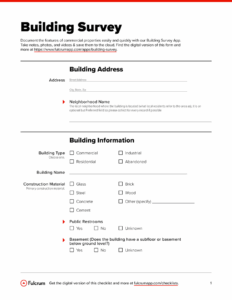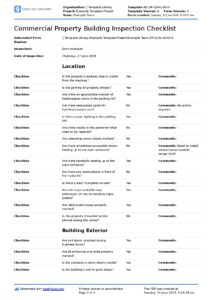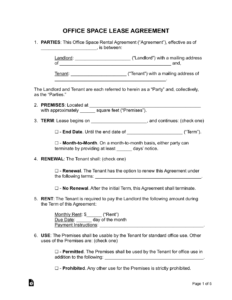Embarking on a new property lease or acquiring a building involves a multitude of important steps, and among the most crucial is understanding its current state. A schedule of condition survey serves as a detailed snapshot, meticulously documenting the existing condition of a property at a specific moment in time. This vital document acts as an impartial record, protecting the interests of all parties involved, particularly in scenarios like commercial leases, where liabilities for repairs can be significant.
Often, the thought of compiling such a comprehensive report can seem daunting, akin to navigating a complex maze of structural elements, finishes, and services. This is precisely where a well-structured schedule of condition survey template becomes an invaluable asset. It transforms a potentially overwhelming task into a systematic, manageable process, ensuring no critical detail is overlooked and that your documentation is both thorough and professionally presented.
Why a Schedule of Condition Survey is Indispensable
A schedule of condition survey is far more than just a formality; it’s a strategic tool that safeguards property owners, tenants, and developers alike. Its primary purpose is to establish a clear, irrefutable record of a property’s condition before a lease commences, before significant alterations are made, or when taking possession. This detailed inventory, often accompanied by photographic evidence, provides a baseline against which any future changes or dilapidations can be measured. Without such a record, disputes over damage or deterioration at the end of a lease or project can become contentious and costly, leading to protracted legal battles and unexpected financial burdens.
For tenants, this document is a shield against unfair dilapidation claims. Imagine moving into a commercial property that already has a few cracked tiles or scuffed walls. Without a documented schedule of condition, you might be held liable for these pre-existing issues when you vacate the premises. Conversely, for landlords, it ensures that tenants are held accountable for any damage beyond fair wear and tear that occurs during their occupancy. It sets clear expectations and minimizes ambiguities, fostering a more transparent and harmonious relationship between parties.
Beyond typical lease agreements, these surveys find critical application in other scenarios. For instance, before undertaking significant construction or renovation work on an adjacent property, a schedule of condition survey of neighboring buildings can be crucial. This proactive measure documents their current state, offering protection against claims of damage caused by your construction activities. It’s also highly beneficial for insurance purposes, providing a definitive record that can support or refute claims should unforeseen events occur.
The true value of a schedule of condition survey lies in its thoroughness and the objective nature of its reporting. It necessitates a systematic approach, examining every accessible part of the property, from its foundational elements to its decorative finishes. This meticulous process ensures that all material facts are recorded, providing a comprehensive overview that leaves little room for misinterpretation.
Key Elements to Document
A robust schedule of condition typically breaks down the property into logical sections, ensuring every area is systematically assessed. While the specifics can vary based on property type, some common elements consistently require detailed attention:
- Structural Elements: This includes the foundations, external walls, roof structure, chimney stacks, and any visible signs of dampness, cracking, or movement.
- External Finishes: Examination of rendering, brickwork, external joinery (windows, doors, frames), gutters, downpipes, fascias, and soffits.
- Internal Finishes: A comprehensive look at internal walls, ceilings, floors, skirting boards, architraves, doors, and ironmongery. This often notes the decorative state, presence of cracks, stains, or damage.
- Services: While a detailed service test is usually outside the scope, the survey will note the visible condition of electrical fittings, plumbing installations, heating systems, and ventilation units.
- External Areas: This covers driveways, pathways, boundary walls, fences, gates, drainage systems, and any landscaped areas.
- Photographic Evidence: Crucially, high-quality, timestamped photographs should accompany written descriptions to provide visual confirmation of the documented conditions.
Crafting Your Effective Schedule of Condition Survey Template
Having a pre-designed schedule of condition survey template is a game-changer for anyone regularly involved in property management, leasing, or development. It streamlines the entire survey process, ensuring consistency across multiple properties and projects. Instead of starting from scratch each time, you can rely on a structured format that guides you through every necessary step, reducing the chances of overlooking critical details and significantly cutting down on preparation time. This consistency also enhances the professional appearance and readability of your reports, making them easier for all parties to understand and refer to.
An effective template isn’t just a blank form; it’s a thoughtful framework designed for clarity and comprehensiveness. It typically includes dedicated sections for property details, a clear definition of the scope of the survey, and systematic breakdowns of the property’s various elements. Each section should allow for detailed descriptions, notes on specific defects or conditions, and ideally, placeholders for photographic references. The best templates are intuitive, allowing you to move through the property methodically, capturing all relevant information efficiently.
Using a template encourages a systematic approach to documentation. As you walk through a property, you can follow the template’s structure, moving from one area to the next, checking off items as you go. This systematic review ensures that you don’t miss hidden corners or less obvious issues. It also prompts you to consider specific types of damage or wear that might be common in certain areas, guiding your inspection process and ensuring a thorough assessment. Remember, the goal is to paint a complete picture of the property’s state.
One of the greatest advantages of a robust schedule of condition survey template is its adaptability. While a core structure provides consistency, a well-designed template allows for customization to suit different property types, sizes, or specific client requirements. You might need to add sections for specialized equipment in an industrial unit, or perhaps focus more on decorative finishes in a residential property. Being able to tweak and personalize your schedule of condition survey template ensures it remains relevant and highly effective for every unique situation you encounter, providing a valuable tool for your ongoing property documentation needs.
Maintaining a clear and comprehensive record of a property’s condition before entering into agreements or initiating significant changes is not merely good practice; it is a fundamental pillar of effective property management and dispute prevention. Such diligence provides a firm foundation for understanding responsibilities and mitigating potential conflicts that might arise from differing interpretations of a property’s state.
By embracing detailed documentation, you empower all stakeholders with transparency and certainty. It fosters an environment of trust, allowing parties to focus on their respective obligations with peace of mind, knowing that a clear, objective record exists to guide their actions and resolve any future questions.



